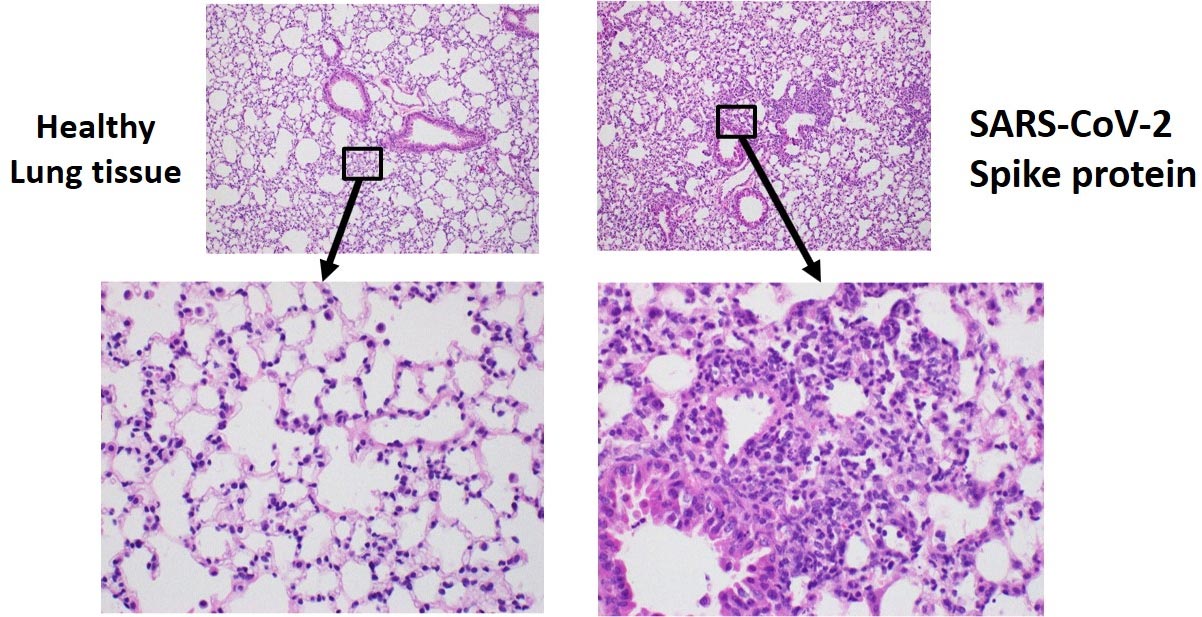SARS-CoV-2 Spike Protein Alone May Cause COVID-19 Lung Damage – Even Without the Presence of Intact Virus
0 View
Share this Video
- Publish Date:
- 30 April, 2021
- Category:
- Covid
- Video License
- Standard License
- Imported From:
- Youtube
Tags

Using a newly developed mouse model, researchers found that exposure to the SARS-CoV-2 spike protein alone was enough to elicit COVID-19-like symptoms, including severe inflammation in the lungs. The left images show healthy lung tissue from mice, while the right images show tissue from mouse lungs exposed to the spike protein. Credit: Pavel Solopov, Old Dominion University
New mouse model makes it easier and safer to study COVID-19 lung injury.
Using a newly developed mouse model of acute lung injury, researchers found that exposure to the SARS-CoV-2 spike protein alone was enough to elicit COVID-19-like symptoms, including severe pneumonia.
SARS-CoV-2, the virus that causes COVID-19, is covered in tiny spike proteins. These proteins bind with receptors on our cells, initiating a process that allows the virus to deliver its genetic material to a healthy cell.
“Our findings show that the SARS-CoV2 spike protein causes lung damage even without the presence of an intact virus,” said Pavel Solopov, PhD, DVM, research assistant professor at the Frank Reidy Research Center for Bioelectrics at Old Dominion. University. “This previously unknown mechanism could cause symptoms before substantial viral replication occurs.”
Solopov presented the new research at the annual meeting of the American Society for Pharmacology and Experimental Therapeutics during the Virtual Experimental Biology (EB) 2021 meeting April 27-30.
Studying SARS-CoV-2 can be challenging as experiments with the intact virus require a biosafety level 3 laboratory. To overcome this hurdle, the researchers created a new model of acute lung injury that uses transgenic mice that express the human receptor for SARS-CoV-2 in their lungs.
“Our mouse model drastically reduces the danger of this type of research by allowing COVID-19 to investigate lung damage without using the intact, live virus,” said Solopov. “This will greatly expand and diversify the opportunity to conduct COVID-19 research. Our model is likely to be useful for studying other coronaviruses as well. “
The researchers injected the genetically modified mice with some of the spike protein and analyzed their response 72 hours later. Another group of mice was only given saline to serve as a control.
The researchers found that the genetically modified mice injected with the spike protein COVID-19 showed like symptoms, including severe inflammation, an influx of white blood cells into their lungs, and evidence of a cytokine storm – an immune response in which the body begins to attack your own cells and tissues instead of just warding off the virus. The mice that only received saline solution remained normal.
“These findings demonstrate that the genetically engineered mouse, along with only a portion of the spike protein, can be used to study SARS-CoV-2 lung damage,” said Solopov. “We can use this tool to better understand how the spike protein causes lung symptoms – even without the intact virus – to develop new targets and therapies for COVID-19.”
The researchers plan to continue this line of research by using the new mouse model to study the effectiveness of various drugs in reducing the severity of acute lung injury and COVID-19.
Reference: “R4183 – Single intratracheal exposure to SARS-CoV-2 S1 spike protein induces acute lung injury in K18-hACE2 transgenic mice” by Pavel Solopov, DVM, PhD, Experimental Biology 2021.










